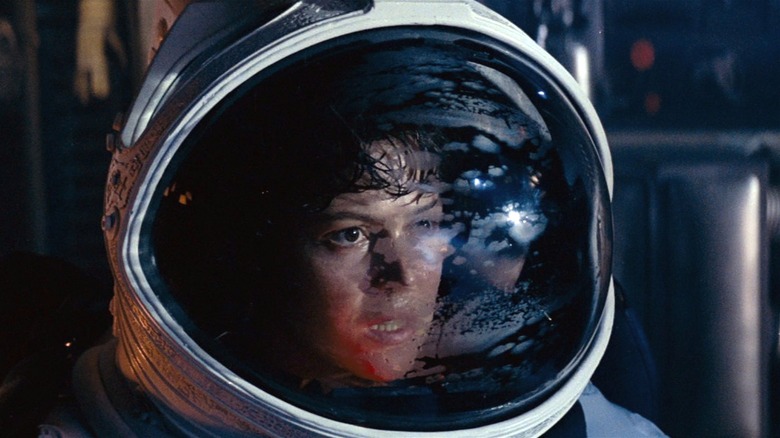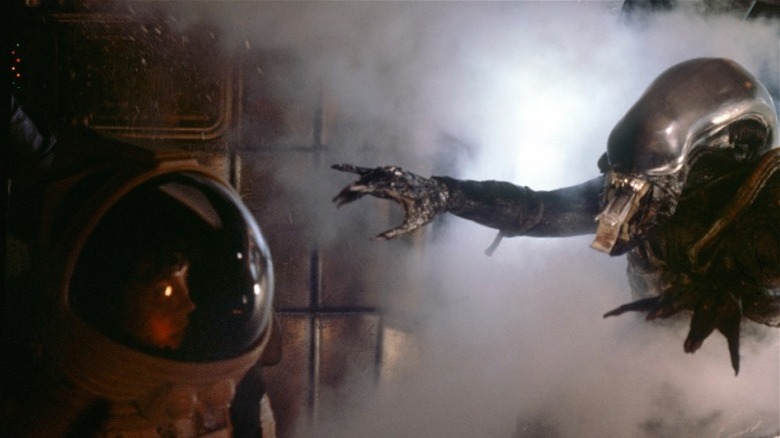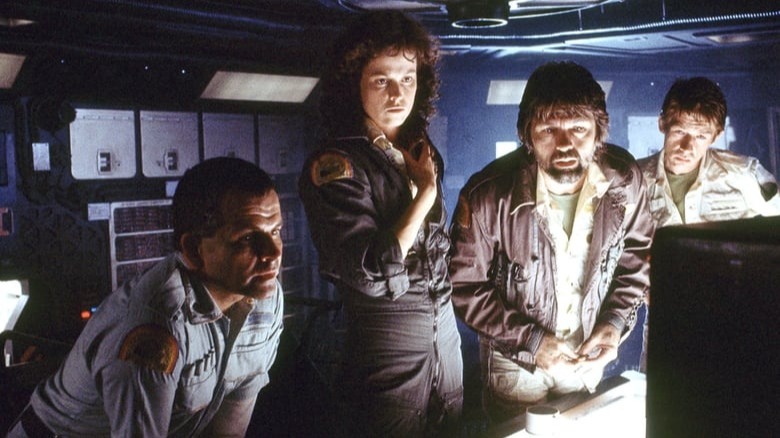Hiring Ridley Scott Boosted Alien's Prospects In More Ways One Than One
After Ridley Scott's "Alien" hit theaters in 1979, the film changed the face of sci-fi space horror. The Nostromo became the site of fresh terror, with a rapidly-evolving xenomorph taking out the competent crew one after the other. Several unspoken rules about horror were shattered at once, especially with Sigourney Weaver's Ellen Ripley, who paved the way for strong, level-headed female survivors in the genre. The film also boasted brilliant practical effects, epitomized in the notorious "chest-burster" scene which even left the actors stunned. While the success of "Alien" and its lasting legacy can be attributed to several elements, the man responsible for bringing everything together was Ridley Scott, who helped boost the odds in the film's favor.
During an interview commemorating the 40th anniversary of "Alien" in 2019, Tom Skerritt, who played Captain Dallas in the film, spoke to RogerEbert.com about Scott's role in upgrading the film's prospects. The actor explained that he had initially declined the film based on a hunch, despite acknowledging that the script had immense potential. As Scott was initially not attached to directing the film, Skerrit had felt that such a script could only blossom in the hands of the right director, and accepted the project once Scott came on board. How did Scott pull together the threads to weave a compelling sci-fi horror?
The stars aligned
Prior to reading the script for "Alien," Skerrit had chanced upon Scott's directorial debut, "The Duelists," a historical drama based on Joseph Conrad's "The Duel." Skerrit explained in the interview linked above that he considered "The Duelists" a "masterpiece" and appreciated "the way...it was framed, the way it was shot, the lighting, [and] the depth of field." In a serendipitous turn of events, Skerrit got a call from the producers of "Alien," who informed him that Scott was now attached as director and that the budget had leaped from $2 million to $10 million.
Skerritt's initial uncertainty about the film's chances at success dissolved after Scott's involvement, as he was not only a good fit for the project but also helped bump up the budget significantly. A bigger budget would mean that the crew could do their best to bring the script's vision to life and work towards enhancing the film's world-building. As the xenomorph acted as the crux of the film, it was crucial to get its design right, to the point that it could evoke unfiltered fear in the characters and audiences alike.
Making good use of the increased budget, Scott collaborated with surrealist artist H. R. Giger to bring the "perfect organism" to life, which included every birth stage of the creature, etched with a love for surrealist harbingers of horror and tremendous attention to detail. Moreover, thanks to Scott's deft direction, the already-promising script for "Alien" transformed into something more impactful, leading to a narrative that touches upon layered themes and invites multiple, interpretative theories.
True creativity demands freedom
Apart from crediting Scott's involvement in elevating the odds for "Alien," Skerritt also touched upon the on-set collaborative process that helped engage creative freedom. He said:
"The more that a writer puts into making a solid screenplay, that inspiration goes to the director and goes to the creative people and everyone becomes engaged with it...There is no right or wrong about this. It is what you listen to and how you separate the wheat from the chaff, as it were. You cannot tell creative people how to paint a portrait. If you do, you don't deserve the artwork."
Here, Skerritt is referring to the joy of collaborating in a creative environment, where ideas and fresh perspectives are welcome. However, he also notes that an artist who is worth their value knows how to separate great ideas from not-so-great ones, as one suggestion can open a brand new direction for a creative project. There is no space for coerced ideas on an artist's canvas, as it is up to a creative visionary as to what colors they wish to use.
While Scott invited inputs on the set of "Alien," it was up to him and his crew to decide the direction of the film. The wild creative swings and directions taken ultimately worked in favor of "Alien," which still holds up after 40-plus years since its release, and still inspires creatives to forge their own path in their respective space horrors and creature features.


